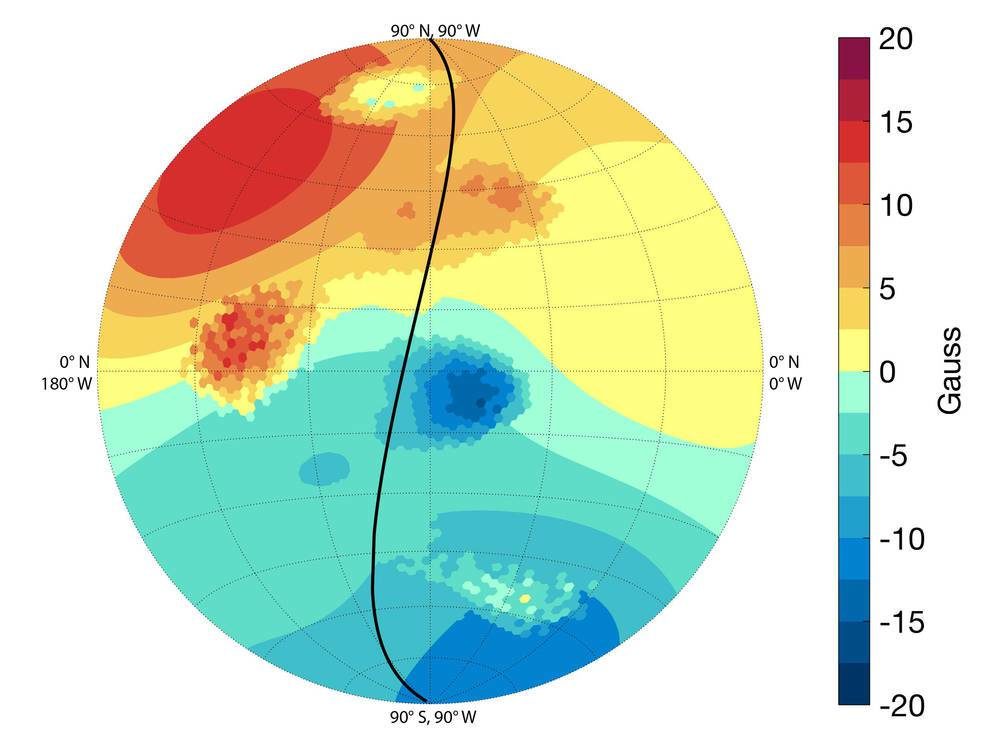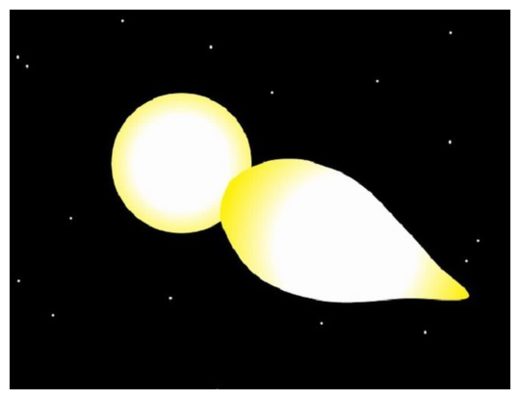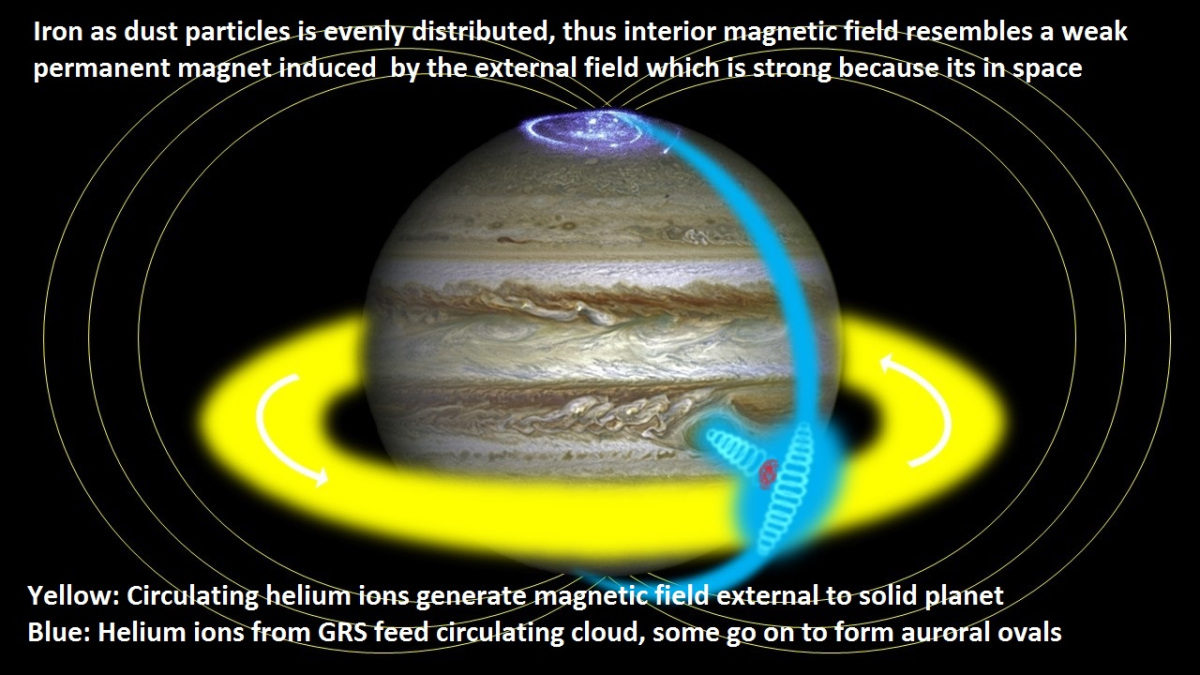The original solar system comprised only the giant planets which incorporated greatly enhanced concentrations of deuterium. Deuterium enhancements of 1010 observed in Large Dark Nebulae (LDN) and heavy elements detected by Galileo (C, O, S, Ar, Kr and Xe) suggest the giant planets in the solar system accreted slow and cold (20º K) from snowflakes and dust at their current orbits, forming frozen, highly deuterated Methane Gas Hydrate bodies (MGH), together comprising > 300 earth masses of water. Jupiter incorporates the heavy elements as dust grains, which are uniformly distributed throughout the solid planet resulting in Jupiter's high density, 1.33, compared with pure MGH, 0.9 g/cm3. A recent (6,000 years BP) high energy impact on Jupiter triggered a massive nuclear fusion explosion of the local deuterium, which ejected proto-Venus plus the Galilean moons. The impact also expanded the incandescent atmosphere of Jupiter tenfold, initiating a continuous fusion reaction in the impact crater. A hot plasma plume from this reaction, named Juno in Roman myth, originally extended 2 x 106 km from the impact site at 22 ºS Latitude, beyond Callisto, rotating rapidly with Jupiter. It slowly diminished over ~ 5000 years, sweeping over the Galilean moons every eight or nine hours, resulting in the higher densities and temperatures of the inner Galilean moons. The longevity of the plume confirms the high deuterium content of our giant planets, a feature observed in a small number of Large Dark Nebula such as 1689N (Roueff).
The fusion reaction on the surface of Jupiter, some 700 km below the cloud-tops, has diminished to the lowest temperature reaction known: d + p →3He+ + γ. The kinetic energy of the helium ions produced by this reaction is producing Jupiter's atmospheric temperature excess and its multiple zonal wind bands - actually vortices constrained below by the solid MGH surface. The reaction is generating 1030 relativistic helium ions per second with velocities >20,000 km/s, which rise in a hot vortex, due to the powerful Coriolis effect. It is swept west below the clouds some 50,000 km due to the rapid rotation of Jupiter, exiting the atmosphere through the Great Red Spot along with the standard solar system abundances of heavy elements which are continuously being released from the MGH by the heat of the fusion reaction. Although at 22 º S Lat. this constant momentum exchange results in a hot surface equatorial wind super-rotation sensed by the MWR, but currently misinterpreted as a 'pancake' layer of ammonia in the interior of a 'gas giant'.
A 'tornado' of helium ions exits through the Great Red Spot, impacts the helium ion plasma cloud that orbits Jupiter (prograde), currently known only as the inner radiation belt, imparting the angular momentum of the rapidly rotating Jupiter and adding ions to replace those being lost to space. The massive number of relativistic helium ions the plasma cloud constitutes an electric current of 150 million amperes which creates Jupiter's magnetic field. It is tilted relative to the equator because the plasma cloud originates from the Great Red Spot at 22⁰ S Latitude. The positively charged cloud external to Jupiter generates its powerful magnetosphere unobstructed by the solid planet, as in the magnetic field of the Earth. Jupiter's magnetic field is opposite the field of the Earth, with north magnetic field corresponding to north geographic pole due to the prograde circulation of the positive ions in the cloud.
The highly energetic helium ions (>20,000 km/s) exiting from the GRS which pass through the plasma cloud at the O'Donaghue 'hot spot' are captured in the external magnetic field and deflected helically to the poles creating the constant auroral ovals. The ovals are constant because the fusion reaction is constant. The helium ions are stable and produce no recombination radiation, however their helical motion is observed from the Earth as partially polarized decimetric synchrotron radiation, currently not understood. Helium ions have a theoretical hyperfine transition between ground states at 3.46 cm which cannot be detected by any instrument on Juno. However, due to their great numbers surrounding Jupiter, they could easily be detected by radio telescopes on Earth supporting the mission but are currently not being sought.
Juno Data - A Whole New Jupiter: First Science Results from NASA's Juno Mission

The Jupiter Energetic-particle Detector Instrument (JEDI) has failed to identify the relativistic 3He+ ions with velocities as high as 20,000 km/sec surrounding Jupiter because it is too small to measure their unexpectedly short time-of-flight through the detector. However, the JEDI scientists have announced that unknown particles are penetrating the JEDI electron detector "leaving behind a fraction of their actual energy". A second manifestation of the high energy helium ions are tiny explosive impacts on the Juno solar panels, the ejected material of which has been detected by the MAG star-tracker scopes. A third clue to the dominance of helium ions is the finding that the plasma frequency (auroral hiss) above the auroral ovals is lower than the expected value for electrons and protons, because helium ions are slightly more massive. These constitute circumstantial evidence of the currently unimagined dominance of high energy helium ions but do not identify them. Surprisingly, their presence could be easily proven from the Earth by a radio astronomical detection of the 3.46 cm ultrafine transition radiation between their ground states, which would be 'a first' for radio astronomers, since it has only been detected by lengthy integrations of signals from LDNs and planetary nebulae but never from a single identifiable source.
On every science pass, all six channels of the Juno Microwave Radiometer (MWR) radiometer experiment are detecting heat from the same equatorial atmospheric jet super-rotating above the solid MGH surface of the planet. However, due to the current insistence on the 'gas giant' hypothesis, in which each channel was designed to sense radiation originating from different depths, the data is being interpreted as a layer of ammonia at the equator extending deep within the gas planet. But radiometers are passive receivers, not radars or spectrometers, thus the depths of the heat origin are strictly interpretations.
The Juno Radio Science (gravity) experiment is indicating a large "stable" homogeneous mass distribution within Jupiter out to approximately 0.9 RJ rather than the ten to twenty Earth-mass rocky-iron core required in the 'gas giant' hypothesis. The complexities in the medium wavelength gravity results, currently thought to be due to deep flows, are indicative of the very large basins or flooded palimpsests produced by ancient impact explosions suggested in the magnetic field data, the latest of which surrounds the fusion reaction, ~50,000 km east of the GRS at 22⁰ S. Lat. Future perijoves at the same longitudes will prove these are fixed features.
A crucial event for Juno will occur on July 11, 2017, when it is expected to pass over the Great Red Spot, since it will be exposed to the 'tornado' of 1030/sec relativistic 3He+ ions. Unaware of the danger, the Juno team may try to look down into the spot with the MWR, because in the 'gas giant' hypothesis it is thought to be a passive storm, but this would be disastrous. The radiation will penetrate the titanium instrumentation vault and cause the system to go into safe mode or worse yet damage Juno irreparably.
"The duty of the man who investigates the writings of scientists, if learning the truth is his goal, is to make himself an enemy of all that he reads, and ... attack it from every side. He should also suspect himself as he performs his critical examination of it, so that he may avoid falling into either prejudice or leniency."
— Alhazen





Reader Comments
Well, I guess we'll see in a bit over a week if this is true.
The article is interesting, but no cigar. "What we cannot show, we do not know". ~ Jacob Neusner
Neuser's quote is full-contrary to the ancients/elders teachings. They say 99% of life happens in the invisible realm (6th sense) whereas ONLY 1% happens in our 5-senses visible world.
O_o
He was later vindicated regarding Venus projections, high heat, etc. And more will come.
((In fact how can anyone mention the word catastrophism without his name?!?! Ok, I admit I fell madly in love with his books at a tender age, but this is nothing personal!)))
[Link]
[Link]
Immanuel Velikovsky, grandfather of this area of thought.
Arrgh.
[Link]
[Link]